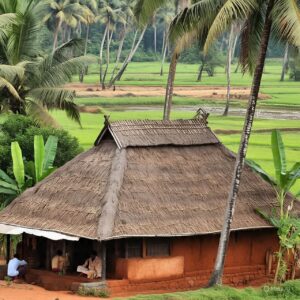
What is an Eco-Village?
To begin with, an eco-village is a community designed for sustainable living. It uses clean energy, grows organic food, manages waste, and builds strong local ties. These villages aim to reduce pollution and help people live simply, with less impact on nature.
In Kerala, these villages are often built near forests, hills, or backwaters. The settings are peaceful and perfect for eco-conscious living.
Why Kerala Is Ideal for Eco-Villages
Kerala already has a deep connection to nature. The state is rich in biodiversity, with many forests, rivers, and wetlands. The people here have long practiced organic farming and natural healing. Many still use herbs, eat local foods, and follow eco-friendly traditions.
Moreover, the government supports sustainable tourism and rural development. Local panchayats and eco-activists are working together to promote green villages. All this makes Kerala a great place for the eco-village movement to thrive.
The Rise of Eco-Villages in Kerala
Over the past few years, eco-villages have grown in number. For example:
-
Vellangallur Eco Village in Thrissur focuses on organic farming and rainwater harvesting.
-
Thenmala Eco-Tourism Village blends tourism with nature education.
-
Wayanad’s Uravu Bamboo Village supports tribal communities and promotes bamboo crafts.
-
Susthithi in Palakkad teaches eco-living and permaculture to visitors and locals alike.
Each village follows its own model. But the goal is the same—to protect the planet and build a better life for all.
How These Villages Work
Most eco-villages in Kerala follow five basic principles:
1. Organic Farming
First, food is grown without chemicals. Villagers use compost, cow dung, and natural pest control. They grow local crops like rice, bananas, pepper, and leafy greens. This supports healthy living and food security.
2. Renewable Energy
Second, many eco-villages use solar panels and biogas instead of electricity from the grid. This cuts down carbon emissions and saves money in the long run.
3. Eco-Friendly Homes
Third, houses are made using mud, bamboo, thatch, and recycled materials. They stay cool in summer and warm in winter. These buildings are cheap to maintain and fit well with the natural surroundings.
4. Waste Management
Next, waste is reduced, reused, and recycled. Kitchen waste becomes compost. Greywater is used in gardens. Plastic is avoided. Clean villages mean clean rivers and cleaner air.
5. Community Living
Finally, people in eco-villages work together. They share food, skills, and resources. Decisions are made as a group. This builds social unity and a sense of belonging.
Eco-Villages and Tourism
Tourism is a big part of Kerala’s economy. Now, eco-villages are offering a new type of travel—eco-tourism. Tourists stay in these villages and learn how to live sustainably. They take part in farming, cooking, craft-making, and nature walks.
This kind of community-based tourism helps both visitors and locals. Tourists enjoy real-life experiences. Locals earn money and keep their culture alive.
In places like Kumarakom and Thekkady, eco-villages are drawing travelers from India and abroad. These projects support green jobs and protect the environment at the same time.
The Role of Youth and NGOs
Young people are also driving the eco-village movement. Many youth-led groups are building model eco-settlements and teaching villagers how to live green. NGOs such as Thanal and Kudumbashree help with funding, training, and awareness programs.
As a result, more villages are adopting sustainable practices. Schools and colleges are also joining the cause by promoting eco-clubs and nature camps.
Benefits of Eco-Villages
There are many reasons why eco-villages are becoming popular. Here are a few key benefits:
-
Healthier lifestyle: Eating fresh, organic food and breathing clean air improves overall well-being.
-
Lower cost of living: Using solar energy, growing food, and reusing materials reduce expenses.
-
Better environment: Eco-villages reduce waste, save water, and protect biodiversity.
-
Job creation: From farming to eco-tourism, new types of work are created locally.
-
Stronger communities: People work and live closely, which builds trust and cooperation.
Challenges in the Eco-Village Movement
However, the journey is not without challenges. Some issues include:
-
Lack of funding for building new eco-villages.
-
Land use laws and local policies that slow down development.
-
Lack of awareness about sustainable living in some areas.
-
Climate change and extreme weather affecting farming.
But Kerala is learning to adapt. With better policy support and more awareness, these problems can be solved.
What the Government Is Doing
The Kerala government is now promoting green projects. The Haritha Keralam Mission supports organic farming and waste management. The Responsible Tourism Mission links rural communities with tourism in a sustainable way.
There are also schemes to encourage solar energy, water harvesting, and eco-entrepreneurship. These steps are helping eco-villages grow faster.
A Model for the Future
Kerala’s eco-villages are not just about going back to old ways. They are about combining traditional wisdom with modern green tech. They show that simple, local solutions can solve big global problems.
As more people look for safe, peaceful, and nature-based living, eco-villages offer a clear answer. They are good for the planet and good for people.
Final Thoughts
In conclusion, the eco-village movement in Kerala is growing fast. It is helping people reconnect with nature, protect the environment, and build strong communities. From sustainable tourism to organic living, these villages offer a glimpse into a better future.
As the world faces climate change and pollution, Kerala shows a new way forward. With the right support, eco-villages could become the model for sustainable development in India and beyond.

Leave a Reply